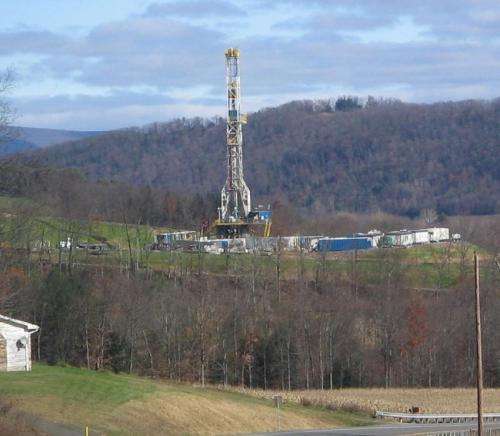July 22, 2014 report
Researchers find greenhouse gas emissions from shale gas similar to that for conventional natural gas

(Phys.org) —A team of researchers with the Joint Institute for Strategic Energy Analysis, in the U.S. has found that greenhouse gas (GHG) emissions that occur during the lifecycle of shale gas when used as an energy source is roughly equal to that which occurs during the life cycle of conventional natural gas. In their paper published in Proceedings of the National Academy of Sciences, the team describes how they used a meta-analytical procedure they call harmonization to arrive at estimates for emissions of GHG due to extraction and use of shale gas.
Extracting gas from shale rock involves injecting fluid into rock areas deep underground, which creates channels through which the gas can be extracted—the technique is known as hydraulic fracturing, which has been shortened, sometimes derisively, to fracking. Once the gas is removed, cement is injected into the site to prevent the injected liquid from entering groundwater—the gas is then processed for use as an energy source, generally by burning it.
Extraction of so-named shale gas has been in the news a lot lately—techniques for extracting it have led to a dramatic increase in supply and a drop in prices. But it's also led to worries about it creating conditions that lead to earthquakes and sinkholes and fears that it might be emitting a lot of greenhouse gases. In this new effort, the researchers note that efforts to estimate the amount of GHG emissions that occur during the entire lifecycle of shale gas have varied, generally due to differing assumptions by those making the effort, baselines used for comparison and system boundaries. They've come up with a new way to measure such emissions, using a meta-analytical procedure they've dubbed harmonization, which they believe offers a true picture of such emissions—they've used it to compare emissions during the lifecycle of shale natural gas, conventional natural gas and coal. In so doing they have found that emissions during the life cycle of shale natural gas are roughly equivalent to that of conventional natural gas, and that both emit roughly half that of coal.
The researchers acknowledge that because their estimates are based on data found in previously published reports, efforts should be made to confirm actual methane emissions at on-site extraction sites by measuring them, along with taking measurements of GHG levels in the local area.
More information: Harmonization of initial estimates of shale gas life cycle greenhouse gas emissions for electric power generation, Garvin A. Heath, PNAS, DOI: 10.1073/pnas.1309334111
Abstract
Recent technological advances in the recovery of unconventional natural gas, particularly shale gas, have served to dramatically increase domestic production and reserve estimates for the United States and internationally. This trend has led to lowered prices and increased scrutiny on production practices. Questions have been raised as to how greenhouse gas (GHG) emissions from the life cycle of shale gas production and use compares with that of conventionally produced natural gas or other fuel sources such as coal. Recent literature has come to different conclusions on this point, largely due to differing assumptions, comparison baselines, and system boundaries. Through a meta-analytical procedure we call harmonization, we develop robust, analytically consistent, and updated comparisons of estimates of life cycle GHG emissions for electricity produced from shale gas, conventionally produced natural gas, and coal. On a per-unit electrical output basis, harmonization reveals that median estimates of GHG emissions from shale gas-generated electricity are similar to those for conventional natural gas, with both approximately half that of the central tendency of coal. Sensitivity analysis on the harmonized estimates indicates that assumptions regarding liquids unloading and estimated ultimate recovery (EUR) of wells have the greatest influence on life cycle GHG emissions, whereby shale gas life cycle GHG emissions could approach the range of best-performing coal-fired generation under certain scenarios. Despite clarification of published estimates through harmonization, these initial assessments should be confirmed through methane emissions measurements at components and in the atmosphere and through better characterization of EUR and practices.
Journal information: Proceedings of the National Academy of Sciences
© 2014 Phys.org

















